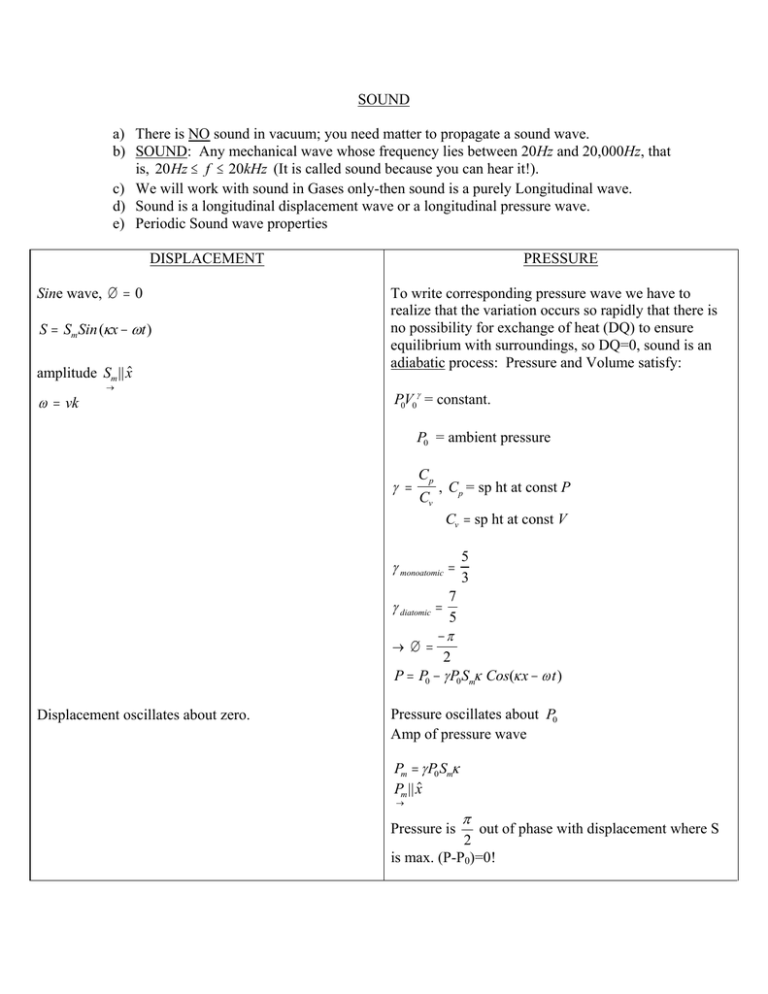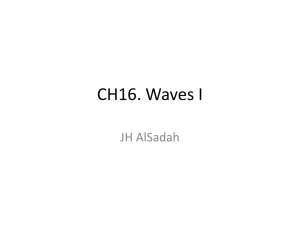κ ω ω = vk
advertisement

SOUND a) There is NO sound in vacuum; you need matter to propagate a sound wave. b) SOUND: Any mechanical wave whose frequency lies between 20Hz and 20,000Hz, that is, 20 Hz ≤ f ≤ 20kHz (It is called sound because you can hear it!). c) We will work with sound in Gases only-then sound is a purely Longitudinal wave. d) Sound is a longitudinal displacement wave or a longitudinal pressure wave. e) Periodic Sound wave properties DISPLACEMENT Sine wave, ∅ = 0 S = Sm Sin (κx − ωt ) amplitude Sm || x$ ω = vk → PRESSURE To write corresponding pressure wave we have to realize that the variation occurs so rapidly that there is no possibility for exchange of heat (DQ) to ensure equilibrium with surroundings, so DQ=0, sound is an adiabatic process: Pressure and Volume satisfy: γ PV 0 0 = constant. P0 = ambient pressure γ = Cp Cv , Cp = sp ht at const P Cv = sp ht at const V γ monoatomic = 5 3 7 5 −π → ∅ = 2 P = P0 − γ P0 Smκ Cos(κ x − ω t ) γ diatomic = Displacement oscillates about zero. Pressure oscillates about P0 Amp of pressure wave Pm = γ P0 Smκ Pm || x$ → π out of phase with displacement where S 2 is max. (P-P0)=0! Pressure is f) Speed of sound in a gas γP0 v= ρ0 = ambient density since PV 0 0 = N k BT [k ρ0 B = 1383 . x10−23 J / K ] If gas particles have mass m, we can write P0 = Nm k B P k T T , or 0 = B V0 m ρ0 m v= v γ k BT = r rms m 3 [T in Kelvin Scale] g) Intensity of sound wave: Imagine that the wave is traveling with velocity v through a tube of cross-section A. Since S = Sm Sin (κ x − ω t ) the particle velocity is Vp = Smω cos(κ x − ω t ) and kinetic energy 1 ρ S 2ω 2 . 2 0 m Volume of wave traveling past every cross-section will be Av in one second. Energy transport per second through area 1 A = A ρ 0 Sm2ω 2v 2 Intensity I=energy transport per second per m2 γP ⎤ 1 ⎡ = ρ 0 Sm2ω 2v ρ 0 = 20 ⎥ ⎢ 2 v ⎦ ⎣ ω2 1 = γP0 Sm2 v 2 per unit volume is K ⋅ E = 1 2 ω2 ⋅F Please compare this with energy transport per second on wire P = A v 2 h) Smallest discernable intensity is I 0 = 10−12 Watt / m2 So we define decibels db = 10 log That is 90db sound has 9 = log I [bel comes from Alexander Graham Bell] I0 I , I = 10−3Watt / m2 10−12 . , P0 = 105 N / m2 ) , i) Amplitude of displacement wave for I 0 ( w = 103 rad / s, γ = 14 1 S 2 x106 x14 . x105 x m 340 2 − 10 Sm ≅ 10 m 10−12 = Roughly equal to diameter of hydrogen atom. REMARKABLE!!! That is your ear is sensitive to motion of air molecules where displacement is equal to the diameter of a hydrogen atom. Congratulations!!

